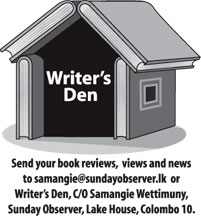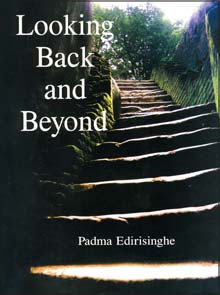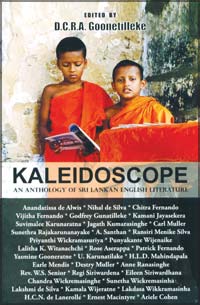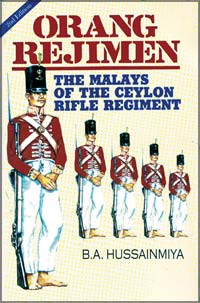|

Positively Black
Title: Looking Back and Beyond
Author: Padma Edirisinghe
Reviewed by Aditha Dissanayake
 Can
you imagine the trauma of losing a sibling when you are six years old?
Or even worse, can you imagine the trauma of overhearing the adults say
"Aney Apoy (Alas!)it is the fair and beautiful one who has died", at the
funeral without feigning they wished you "the Ugly Duckling, the Dark
skinned one" were in the coffin instead of your sister? Consider
yourself lucky if you have only to imagine such horrors. For Padma
Edirisinghe, they are real. Her memoirs, though she does not wish to
call them as such, preferring to treat them as nostalgic reminiscences
will touch the hearts of anyone who has suffered because his or her skin
colour is not the same as this paper you are holding in your hands right
now. Can
you imagine the trauma of losing a sibling when you are six years old?
Or even worse, can you imagine the trauma of overhearing the adults say
"Aney Apoy (Alas!)it is the fair and beautiful one who has died", at the
funeral without feigning they wished you "the Ugly Duckling, the Dark
skinned one" were in the coffin instead of your sister? Consider
yourself lucky if you have only to imagine such horrors. For Padma
Edirisinghe, they are real. Her memoirs, though she does not wish to
call them as such, preferring to treat them as nostalgic reminiscences
will touch the hearts of anyone who has suffered because his or her skin
colour is not the same as this paper you are holding in your hands right
now.
The colour of one's skin matters not only in America, though now with
the first African American president in the White House things may
change, but here, in this land too where even though the official colour
of every citizen is brown (thala-elalu) preference is given to the
fair-skinned when it comes to matrimony, beauty contests and even love.
Yet, this was not so in the past. Padma believes this preference for
the white skin over black came only after the European invasions."Sri
Alawattage's research gives some intriguing facts about the attitude of
the ancient people towards a woman's skin colour" she writes, "an
attitude which is strangely much more sophisticated than now leading one
to wonder whether the Whitewashing process of the Whites was in some way
responsible for the total disparagement of the dark colour.
Though she had often wished her skin had not been as dark as it is,
what is alluring in Looking Back and Beyond is the way, in spite of this
handicap, and many more, for she believes her whole family has been
under an evil spell from the moment her parents shifted to a house in
which the previous owner had "planted a hooniyam" she deviates from the
trodden path and transforms her life into an odyssey.
Her spirit of adventure, her thirst for knowledge, her never ending
curiosity, which lead to memorable experiences, and which she recreates
in the book with open intimacy, makes you turn the pages, often against
your will.
The more you try to skip some of the particularly morbid descriptions
the more your resistance weakens and you find yourself wishing for more.
For, Padma Edirisinghe keeps dangling the carrot in front of your nose
and takes it away the moment you believe you are going to take a
satisfactory bite.
Thus, just when you get interested in a certain description she stops
talking about it and moves onto another and another and another. Now is
the time for everybody who had thought Henry Fielding is the Master of
digressions to change their minds. Looking Back and Beyond surely
surpasses any book in existence when it comes to digressions. It is hard
at times not to ask yourself where is the plot? Is the whole book one
whole story of digressions?
Consider the first chapter. You find yourself in the village of
Humbutiyawa on a "wretched night" shivering at the sound of the
orchestra of jackals. "Outside it was frightfully dark, the familiar
trees themselves giving a show of gruesome phantoms as they swayed to
and fro in obedience to the gusty winds.
The stage was set..." Set for what? Oh, no! Before you learn about
the tragic events of that morbid night you must read about "hulang", and
about Bella Woolf sister of Leonard Woolf who wrote the first pocket
book on Sri Lanka and about the Brindavan Gardens of India where you
will come across plenty of napunsakayas - males who camouflage
themselves as females, and about the difference between the Christian
year and the Buddha year, as well as a description of an imagined or
otherwise, encounter with Charles Dickens at his residence in London.
Out of breath already? But the topsy turvy events are full of useful
information, and described in such an engaging, humorous manner, i.e.
"the water project...ended in hulang (nothingness in a literal sense)
while the hulang project itself made headway" you are bound to feel
pleasantly intoxicated with an abundance of knowledge you would never
feel like reading had you come across them in an encyclopedia.
Looking Back and Beyond is indeed exactly what the words describe.
Here is a book which looks not only look at the past, but beyond the
past as well.
By the time you reach the last page you are bound to feel the
writer's address ought to be Padma Edirisinghe, Earth, Solar System, the
Universe.
Here is someone, who, in spite of her qualms about her skin colour
has proven, black is definitely better.
Mirroring a people and writings from different angles
Kaleidoscope: An Anthology of Sri Lankan English Literature.
Edited by D.C.R.A. Goonetilleke.
Reviewed by E.A. Gamini Fonseka
 Emeritus Professor D.C.R.A. Goonetilleke's Kaleidoscope is a welcome
contribution to the reading of Sri Lankan literature in English. The
anthology includes some thirty-four writers some of whom are well-known
and some not so. Emeritus Professor D.C.R.A. Goonetilleke's Kaleidoscope is a welcome
contribution to the reading of Sri Lankan literature in English. The
anthology includes some thirty-four writers some of whom are well-known
and some not so.
As each piece of writing is unique in texture and meaning, the
kaleidoscope metaphor that the anthologist uses to describe his
collection aptly connotes the materiality of language as well as the
multiplicity of the experience it engenders.
The sources from which these writings are selected are varied.
Anthologies of Sri Lankan Literature in English are only a few in
number. Goonetilleke, DCRA (ed.) Modern Sri Lankan Stories (1986),
Modern Sri Lankan Poetry (1987), Modern Sri Lankan Drama (1987), The
Penguin New Writing in Sri Lanka (1992), The Penguin Book of Modern Sri
Lankan Stories (1996), Sri Lankan Literature in English 1948-1998: A
50th Independence Anniversary Anthology (1998), and Wijesinha, Rajiva
(ed.). An Anthology of Contemporary Sri Lankan Poetry (1993) are the
only recognized anthologies published in Sri Lanka and India that are
easily available to the Sri Lankan readers.
Yet these anthologies are confined to the genres they each represent.
Obeysekera, Ranjini & Chithra Fernando (eds.) An Anthology of Modern Sri
Lankan Writings in English (1981), published in Arizona, contains
predominantly their own translations of works originally produced in
Sinhala. The genre of drama is not represented in it.
To these we might add Kanaganayakam, Chelva (ed.) Lutesong and Lament
- Tamil Writings from Sri Lanka (2001), published in Toronto, which is a
compilation of translated verses of vernacular Tamil poetry and prose
from Sri Lanka. Compared to all these collections, Kaleidoscope remains
a unique compilation because it includes not only works in all the three
major genres - poetry, prose, and drama - produced originally in English
by members of the Sinhala, Tamil, and Burgher communities in Sri Lanka,
but also non-fiction. It is obvious that Professor Goonetilleke has
contributed significantly to the post-colonial project of setting up of
a distinct corpus of Sri Lankan writing in English.
The anthology starts with an insightful introduction where the author
provides the background to the works.
The social, economic and political climate the middle class of Sri
Lanka enjoyed during colonial times, the revolutionary situations that
arose after Sri Lanka received independence from the British Crown in
1948, the aesthetic and social sources from which the poets working in
English drew inspiration in the literary and conceptual organisation of
their material, the cultural exposure the local writers have received in
foreign lands, terrorism initiated by the militant group LTTE that
demands a separate state within the island of Sri Lanka, and the ethnic
unrest arising out of the dissatisfaction of the Tamil community with
the rights extended to them in independent Sri Lanka are some of the
topics that are dealt with in the Introduction.
The book carries three sections: Fiction & Non-Fiction, Poetry and
Drama. The Fiction section contains sixteen stories; the Poetry section,
twenty-seven poems, and the Drama section, two one-act plays.
The Fiction section, which occupies a larger part of the book,
organises its contents under four themes: Urges, Divisions, Catastrophe
and Excerpts. While Anandatissa de Alwis' Prema becomes jubilant about
his potential as a promising lover to an American woman in her forties,
Godfrey Gunatilleke's Tissa in his mid-thirties is concerned about his
nuptial obligations to a teenage wife. While Rassan and Selvam's sons in
A. Santhan's paradoxical story thrive after migrating to America,
Australia, and the UK in fear of ethnic violence (they have entered
those countries as refugees and now own valuable real estate there and
their parents boast about their achievements), Duminda in Punyakante
Wijenaike's story turns into a mental patient, injured in the
battlefield. Suwimalee Karunaratna's Lata ends up a victim in a "snare"
in the clutches of "the underworld king" Kam, while Sunethra
Rajakarunanayake's Nirmala Walikumbura cultivates resilience to manage
her life in her cosmopolitan social milieu in the USA. Ariele Cohen's
true life drama emotionally portrays the pulse of the Sri Lankans in a
tragic situation where compassion and humanity are the most needed.
Indeed the people of Sri Lanka appear in many moods and forms in the
sixteen stories Goonetilleke has selected.
The twenty-seven poems in the Poetry section feature the evolution of
Sri Lankan verse in English. The tranquil origins of Sri Lankan poetry
which flourished with the poetic creations by sympathetic colonial
influences such as Rev. Fr. W.S. Senior have changed.
The new generations have started using poetry as a medium to react to
various complex social, political and cultural issues and upheavals in
the small community of post-colonial Sri Lanka. Breaking with the
tradition of the Kandy Lake poets who were often sentimental and
complacent in their thinking, Sri Lankan poetry becomes more and more
committed and provocative through the involvement of poets and writers
like Yasmine Gooneratne, Patrick Fernando, Lakdasa Wickramasinha,
Lakshmi de Silva, HLD Mahindapala and Anne Ranasinghe.
The entries from Regi Siriwardena, Kamala Wijeratne, Chandra
Wickremasinghe and others are direct reactions to violence which took
place in the recent past. Poetry becomes an instrument of social and
political criticism in their hands.
The Drama section includes the pioneering dramatist H.C.N. de
Lanerolle's Fifty-Fifty, which is a comment on "the Tamil demand for
representation in the State Council equal to the Sinhalese in the then
new dispensation," (xviii) in the form of a farce. It also features The
Loneliness of the Short-Distance Traveller, a play by Ernest
Thalayasingham Macintyre, the most talented of Sri Lanka's dramatists.
This dramatic text can be read as an absurdist attempt to focus
critically the destiny of people suffering from chronic frustration and
irritation as a result of a dull monotonous lifestyle.
The political and racial rift between the Tamils and the Sinhalese
depicted in Lanerolle's play is a condition that could find echoes in
any country where the native groups become adversaries to each other as
a result of the imperial divide-and-rule strategy practised in the past.
Macintyre's play comments on the root-cause of post-colonial unrest in
Sri Lanka which is precipitated by underdevelopment, the urban rural
divide and class differences.
While one-act plays of this length are not many in number to get into
a book like this, these two plays adequately represent Sri Lankan talent
in realistic and experimental theatre.
Deviating from the current fashion, Goonetilleke has not included the
Burgher poet Jean Arasanayagam and the occasional Tamil poet Suresh
Canagarajah in his anthology. He has explained his rather harsh stand
with regard to them in his earlier review of their work in a chapter
entitled "Sri Lanka's Ethnic Conflict; Fact and Fiction" that he wrote
for Sri Lankan English Literature and the Sri Lankan People 1917-2003:
"These writers seem to write for one another, for the local critics, for
a few readers of their own class, and for a corresponding class in the
developed world rather than for those actively engaged or involved in
the struggle."
The omission of their work has been counterbalanced in the anthology
by the inclusion of Tamil writers such as A. Santhan, Rose Aserappa, and
Ernest Macintyre who deal with some interesting issues of the Diaspora.
As a whole, the book is a valuable guide in furthering the cause of
establishing and promoting a distinct Sri Lankan literature in English,
as it shows how a community raises its multiple voices in a language
inherited from one of its colonial masters.
Works Cited Gonetilleke, DCRA. Sri Lankan English Literature and the
Sri Lankan People 1917-2003. Colombo: Vijitha Yapa Publications. (2005),
82
In depth study of Sri Lankan Malays
Orang Rejimen Dr. Hussainmiya
Reviewed by Nilma Dole
More often than not, little is known about the Malay community who
make up a small percentage of the total population in Sri Lanka. Being
an ethnic minority, many are not aware of the extent to which Malays
have gone to preserve their cultural identity that is prevalent among
these people even today.
 Even with intermarriages with other ethnic communities and the
younger Malays not conversing well in the Malay language, many have
managed to keep a part of their culture be it in the spheres of food
they eat, the clothes they wear or the names they have chosen to call
their descendants. Even with intermarriages with other ethnic communities and the
younger Malays not conversing well in the Malay language, many have
managed to keep a part of their culture be it in the spheres of food
they eat, the clothes they wear or the names they have chosen to call
their descendants.
For those who have no clue whatsoever about the Malays or those who
have an identity crisis with questions about where they came from, the
book Orang Rejimen (2nd edition) by Dr. B.A. Hussainmiya is a must to be
in every Malay's bookshelf. Encompassing everything from Malay history,
language, culture, literati and even the story of the first Malay
settlers in Sri Lanka, the book gives a refreshing outlook to the race
who came to Sri Lanka as two groups - one as soldiers to serve the Dutch
and those who came later as Indonesian political exiles or `Staatsbannelingen'
to the island. The Malays have traditionally chosen a career in the
military and even today these patriotic citizens of Sri Lanka continue
to serve their adopted country like their ancestors.In another aspect,
Dr. Hussainmiya offers various revelations that are of particular
interest to the reader. One eye-opener is `It seems likely that the
majority of the early Malays brought here to serve in the native army
really had Batavia as their point of origin." With regard to the early
Malay population's language, there has also been a connection where the
simplified Malay language, the `Batavian Malay' was also adopted as the
main medium of communication. The Batavian Malays were recruited
annually from Batavia to fill in for discharged soldiers.Documenting
evidence about the fact that the Malays have attacked the British three
times with the fall of Colombo and the British decision to send the
Malays to Madras also offers us an insight as to how the Malays braved
many a storm to rise up to challenge.
Further more, Dr. Hussainmiya delves deep to enlighten about the
formation of the Ceylon Rifle Regiment, the actual life-blood of the
Malays - `In 1805, when Governor Frederick North left the island, it
seems that there was to be a serious reversal in the official British
policy of preferring Malays as soldiers in the native military service'.
Dr. Hussainmiya highlights Malays' continuation in literature like
the Alamat Langkapuri, which was published by lithograph in 1869, in
Colombo, by the great Sri Lankan Malay literary savant, Baba Ounus
Saldin which is historically the first newspaper published in Sri Lanka.
The book also has new photographs, literary texts, memoirs and
various treasures uncovered by Dr. Hussainmiya about the Malay
connection. As the former advisor to the Sultan of Brunei, Dr.
Hussainmiya has documented the great Sultan's biography after
considerable research. Now attached to the Universiti Brunei Darussalam
as an Associate Professor, he brought the second edition as a result of
many plagiarising his work. The first edition, published in Malaysia by
Universiti Kebangsaan about twenty years ago, was not available to all
but with the revised one, Sri Lankans can now learn from this Malay
scholar about the great community knowas the Malays.
****************
Books on Buddhist research:
by U. D. Disaratne
Some of these places where the Buddha has visited in India have been
found by archaeologists through their painstaking research and
excavations and even the routes he has taken during these wanderings
have been brought to light.According to modern researches the early
Indian literature belonged to the early Vedic period. The natural
elements like Agni, Soorya and Maruts are gods of mid air. Agni and Soma
are gods of the earth. Indo Aryans worshipped all the natural elements
and performed different kinds of sacrifices and rituals in order to go
to heaven. The Buddha appeared in India with this historical background
and he challenged the Brahmanical rituals and sacrifices. This
illustrious son of India was a practical reformer and his objective was
to secure deliverance from the grim reality of suffering. After
realisation of Buddhahood at Uruwela he went forth preaching the Dhamma.
He went from village to village, township to township with his retinue
of Sangha.
Those who are interested in the latest research on Indology with
special reference to Buddhism can contact Motilal Banarsidass Book House
in Delhi on email [email protected] (Motilal Banarsidass, 40, Bungalow Road,
Jawahar Nagar, Delhi, India) |

